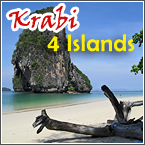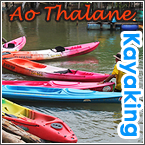Hoi Chak Teen
July 12, 2010 by admin
Filed under Local Delicacy
![]() ‘ FEET PULLING SHELLS ‘
‘ FEET PULLING SHELLS ‘
Known as “Hoi Chak Teen” in Thai or as a type of wing-shell that belongs to the Strombus Canxarium family. It looks like a conch but is smaller and brown in color. Its special characteristic is its dark brown walking legs which are referred to as “feet” or “teen” (in informal Thai). It is also known to the Indonesian in Riau Archipelagos as ” Gong Gong.” This local seashell is recognize as a seafood delicacy in Krabi. It is commonly found at the river mouth near sandy banks such as areas around Koh Jum and Koh Siboya. Harvesting is only done by the local fishermen twice a month during the receding spring tide. To prepare the dish, the wing shell is soaked in salty water for about half an hour. A few crushed chilies are added to the water to make it spicy. The wing shell then begins to move, pushing its feet out and expelling the mud from inside. It is rinsed several times and then put in to a pot of cold water. The pot is then put on the stove to boil and when the water gets warm, the wing shell pushes its feet out. As soon as it is cooked, it is ready to be served. To eat the morsel, you pull the feet and the mollusk will come out. You can also use a toothpick to reach into the shell and pull all the meat out of the shell in one go. It is eaten with a dip made of garlic, chilies, sugar, lime juice and fish sauce. The shells are also made into decorative items for the home or sold as souvenirs.
50,000 dog conches, known in Thai as ‘Hoy Chak Teen’, were released into the sea off the Sri Boya Island in Krabi’s Nua Klong district in December in tribute to HM the King’s 80th Birthday Anniversary. The location was chosen for the release of the sea creatures due to its natural fertility of sea grass and sea weeds in Thailand. It also originated the breeding of dog conch which today became famous sea food for the Andaman region. The activity was carried out by the Power Plant in Krabi under the Electricity Generating Authority of Thailand or EGAT and local people of the Sri Borya Island. Paitoon Suwanboriban, Director of Krabi Power plant : “We have consulted local villagers and they agreed, so we carry out the project. We just hope to increase the number of the dog conch.” The dog conch is now becoming Krabi’s cash animal as visitors to the province ask for the dish always listed in local restaurants’ menus. It costs around 120 baht per dish. The popularity with high market demand raised concern among locals that the dog conch would rapidly decline in number. Local villager of Sri Borya Island in Krabi : “Villagers here used to collect a large amount of dog conch each day, as much as 10 kilograms per person. These days if you can collect 3 kilos that’s good enough. It declines sharply.” The concern led to Power Plant in Krabi conducting the cultivation and breeding and releasing baby ones into nature. They also took the opportunity to educate, to raise awareness among local residents to collect the sea food only when they are mature so that it leads to sustainable living of dog conch, with the sea grass and also the economy for people at large.
” Hoi Chak Teen “
embedded by Embedded Video
















